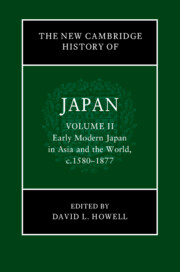Book contents
- The New Cambridge History of Japan
- The New Cambridge History of Japan
- The New Cambridge History of Japan
- Copyright page
- Contents
- Figures
- Maps
- Tables
- Contributors to Volume II
- Preface
- Frontispiece
- Introduction
- Part I The Character of the Early Modern State
- PART II Economy, Environment, and Technology
- 7 International Economy and Japan at the Dawn of the Early Modern Era
- 8 The Tokugawa Economy
- 9 The Pacific Context of Japan’s Environmental History
- 10 Scientific Communities and the Emergence of Science in Early Modern Japan
- 11 The Problem of Western Knowledge in Late Tokugawa Japan
- 12 Technology, Military Reform, and Warfare in the Tokugawa-Meiji Transition
- Part III Social Practices and Cultures of Early Modern Japan
- Index
- References
7 - International Economy and Japan at the Dawn of the Early Modern Era
from PART II - Economy, Environment, and Technology
Published online by Cambridge University Press: 15 January 2024
- The New Cambridge History of Japan
- The New Cambridge History of Japan
- The New Cambridge History of Japan
- Copyright page
- Contents
- Figures
- Maps
- Tables
- Contributors to Volume II
- Preface
- Frontispiece
- Introduction
- Part I The Character of the Early Modern State
- PART II Economy, Environment, and Technology
- 7 International Economy and Japan at the Dawn of the Early Modern Era
- 8 The Tokugawa Economy
- 9 The Pacific Context of Japan’s Environmental History
- 10 Scientific Communities and the Emergence of Science in Early Modern Japan
- 11 The Problem of Western Knowledge in Late Tokugawa Japan
- 12 Technology, Military Reform, and Warfare in the Tokugawa-Meiji Transition
- Part III Social Practices and Cultures of Early Modern Japan
- Index
- References
Summary
In the early modern period, Japan emerged as a key node in global trading networks. While a vast range of goods were traded, Japan’s position was underpinned by the silk-for-silver exchange that acted as a powerful magnet for foreign merchants. This chapter aims to situate Japan within global trade by exploring the underlying commercial dynamic that drove engagement and the crowded commercial landscape that emerged as a result. The focus is, first, on successive challengers including the Portuguese, shuinsen merchants, the Dutch, the English, and the Chinese and, second, on Tokugawa attempts to channel trade through sanctioned pathways while cutting links with any group that might inject volatility into a precariously balanced system. The chapter concludes by examining the Zheng maritime organization, which emerged to challenge the Dutch East India Company for control over trade routes in East and Southeast Asia.
Keywords
- Type
- Chapter
- Information
- The New Cambridge History of Japan , pp. 229 - 266Publisher: Cambridge University PressPrint publication year: 2023



